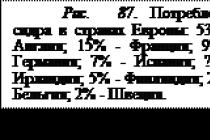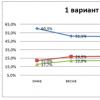Calculation of the cost of goods with a discount or promotion
Very often, various promotions are held in stores, during which a discount is set for a certain group of goods. At this time, you can see, for example, such an ad "For products with a yellow price tag - 30%". In such a situation, it is necessary to correctly calculate the purchase price, to understand which promotions are most beneficial for the family budget. Consider a situation where a certain product is sold at a discount.
A liter of juice cost 85 rubles. There is a promotion in the store, and the juice discount is 30%. How many packs of juice at the old price can be bought for 350 rubles, and how many at the new price?
We find out how many rubles the discount is, for this we write the number of percent as a decimal fraction:
85 0.3 \u003d 25.5 (r.) Or 25 rubles 50 kopecks
Find out the cost of a juice package after the discount.
85-25.5 \u003d 59.5 (r.) Or 59 rubles 50 kopecks
350:59.5=5(15/17), i.e. you can buy 5 packs of juice
You can use another method.
Find out what percentage the new price is from the original one.
We find out the cost of a juice package after the discount, for this we write the number of percent as a decimal fraction:
Multiply the original price by the resulting number:
85 0.7 \u003d 59.5 (r.) Or 59 rubles 50 kopecks
Let's find out how many packages of juice at the old price can be bought for 350 rubles.
350:85=4(2/17), i.e. you can buy 4 packs of juice
Let's find out how many packages of juice at the new price can be bought for 350 rubles.
350:59.5=5(15/17) you can buy 5 juice packs
Quite often, promotions are held in stores: when you buy several products of the same name, you buy the next product at a discount. How to calculate the purchase price?
The store holds a promotion: “Any T-shirt at a price of 500 rubles. Buy two T-shirts and get 60% off the second. How many rubles will you have to pay to buy 6 t-shirts?
We find out how many rubles the discount for the second T-shirt is, for this we write the percentage as a decimal fraction:
Multiply the original price by the resulting number:
Find out the cost of the T-shirt after the discount.
We determine the cost of the purchase, remembering that three T-shirts are 500 rubles each and three T-shirts are discounted, that is, 200 rubles each.
How to calculate the discount in Excel (Excel)?
Let's look at a few issues related to with discount calculation in Excel.
1) There is the original price of the goods, as well as the discount percentage. Need to calculate the price of a discounted item.
Here is a table with this information entered (the discount column should be formatted as a percentage):
To solve this, you need to use the percentage subtraction formula.
It looks like this:
Sale price = Old price - Old price * Discount.
Grapes \u003d 180 - 180 * 0.1 \u003d 162 rubles.
In Excel, the formula for calculating the price with a discount will be as follows (we write it in cell E3):
It remains to copy this formula for other products.
2) To find out what is the discount in rubles, you need to subtract the discounted price from the old price.
Here's what it looks like in Excel:
This is the usual subtraction formula.
3) If the old price and the discounted price are known, then discount percentage can be calculated using the following formula:
Discount (in %) = (Old Price - Discounted Price) / Old Price.
Here is the formula in Excel:
Do not forget that the format of the cells with the result must be made percentage.
Excel is one of the components in the Microsoft office application. This is a spreadsheet with the ability to make mathematical, logical and other calculations automatically using formulas, which allows you to reduce the time of counting manually. An example of the count I created on my PC sample in Excell see the figure below:
- Create a table with five columns;
- Fill in the header: product name, price, rub, 10% discount, discount price, rub;
- Cells C3, D3, E3 are formatted in financial format;
- In cell C3 we put the cost;
- In cell D3 we enter the formula: sign \u003d C3 * 10%;
- In cell E3 we also put the formula: sign \u003d C3 + D3
This is one of the easiest options. Good luck. I will be glad if someone helped.
How to calculate the 10% discount?
Price after discount: 360 rubles
Savings: 40 rubles
Price after discount: 720 rubles
Savings: 80 rubles
Price after discount: 900 rubles
Savings: 100 rubles
Price after discount: 9000 rubles
Savings: 1000 rubles
Price after discount: 27,000 rubles
Savings: 3000 rubles
Price after discount: 72,000 rubles
Savings: 8000 rubles
How to calculate the discount?
To correctly calculate the discount, you must first determine the size of the discount, as well as the amount in relation to which the calculation is made. Usually there are two types of discounts - percentage and fixed. Fixed discounts are used quite rarely, and look something like this: "One hundred rubles from each purchase." This means that you just need to subtract one hundred rubles from the purchase price to get the final amount. To calculate percentage discount, you must first calculate the amount of the discount. For example, if a discount of 5% of the purchase is provided, then the discount will be equal to (purchase amount * 5) / 100. Then we subtract the discount amount from the purchase amount and get the final calculation of the discounted purchase amount.
In this case, the sales agent must be aware of this and is simply obliged to call the office and clarify the price of the goods after the discount, otherwise a conflict with the client cannot be avoided.
Calculations in Excel. Trade margin on the price list in Excel
|
I make my work day easier! How to give a presentation and earn the trust of the audienceHow can an office worker survive without air conditioning?How not to lose business quality in pursuit of quantityTired of losses? We identify unprofitable customersMemories of the futureEXCEL FOR "DUMMIES" AND NOT ONLYHow to make an extra charge on the base price list so that the client does not notice itLet's assume that we have the situation described in the block "To help the merchant". Not only do we need to make a new increased price based on the existing price list, but we also need to do it in such a way that the client does not guess that we have performed some actions on the base price list. We do value our customers! So, our company works with a certain price list:
We plan to give our client a 15% discount and at the same time reach the indicated prices. x = 356 * 100 / (100-15) Open the existing price list in Excel or create a new table in the price list format. If we are working with an existing price list (and it already has a certain format), then the easiest way is to copy one of its columns, insert the required number of new columns on the right Now let's get down to formulas. For clarity and convenience (what it is, we will see later), I propose to introduce a column with the discount value. So we're looking for a premium price. Let's start with Item 1. Let's do the calculations in ExcelWe activate the corresponding cell and write in it WITHOUT SPACES the corresponding characters or activate the corresponding cells in the following order: BASE PRICE * 100 / (100 - DISCOUNT FOR THE BUYER) ENTER If you did everything correctly, you should get 418.82. If you have problems, you can check the formula by staying in the cell and clicking on the status bar: Well, if everything is correct, you can safely copy the finished formula and paste it into the following cells. Moreover, if you need to save the format, you can perform the operation through a special insert by selecting the “formula” for inserting. If you don’t care much about the format, you can simply “stretch” the formula. To do this, place the cursor on the lower left edge of the cell with the formula. A cross will appear. Click on this cross with the left mouse button and drag without releasing your finger down to the end of the list of products. Don't forget to release your finger! So, we have finished calculating prices with a markup to the price list and got the following results: Note that including the discount column in our calculation gives us the ability to change the discount value. In this case, the value of the price with a markup in the Excel format will change automatically. This will make it easier for us to decide on the proposed price. And now, in order to be sure of the correctness of the calculations, we will check. I can offer 2 ways to choose from. In both cases, the discount will be taken as "x". 1 way: using percentages. In this case, it is IMPORTANT to multiply the percentage by the number from which it is subtracted. Thus, we find the percentage of the number that needs to be subtracted from it. Otherwise, you get abracadabra. Let's check our markup price: 418,82 - 15% * 418,82 = 356 2 way: without using interest. The formula will be like this (as usual WITHOUT SPACES in the following order): PRICE * (1 - x / 100) Let's check our price in the second way: 418,82 * (1 - 15 / 100) = 418,82 * 0,85 = 356 The audit showed that we are on the right track! The filigree work remained. Let's cover our tracks. Our task is to get rid of the Base Price and Discount columns. But how do we do that if our new markup price refers to them? Copy the entire column with the new price and paste in the same place "Value" through "Paste Special": It seems that everything worked out! The formula is gone, only the value remains. Now you can delete unnecessary columns. But. Please note that there are a lot of digits after the decimal point in the status bar. This doesn't happen in the regular price range. So our client may suspect a trick. There is only one step left to perfection! We put the cursor next to the cell that we are going to round and go to "Functions". We find rounding in mathematical functions and set the number of digits after the decimal point: It remains to copy the rounding and paste the "values" through the "paste special". Now everything is in order! As if it were! You can delete all unnecessary columns and send a new price list to the client. If after reading the article you still have questions or would like to see certain topics in this section, write me a letter marked "excel" at: What you need to know about HR documentsSeven Rules for Getting RichHow not to miss your luckDolmens - one of the greatest mysteries of the third millenniumCheck if the Labor Code is observed in your companyAnnual paid vacation. What are you entitled to?Using the power of thought is the key to healthWhere do nassamihs live2011-2017 Reprinting of materials is possible only with a direct indexed hyperlink How to calculate the 30% discount? |
|---|
Price after discount: 70 rubles
Savings: 30 rubles
Price after discount: 350 rubles
Savings: 150 rubles
Price after discount: 1050 rubles
Savings: 450 rubles
Price after discount: 17500 rubles
Savings: 7500 rubles
Price after discount: 31500 rubles
Savings: 13500 rubles
Price after discount: 70,000 rubles
Savings: 30,000 rubles
Financial portal Skolko24/7 © 2019. Exchange rates, loans, deposits, ATMs and branches. Find out how much the dollar, ruble, gold is worth today, what is the Bitcoin exchange rate and more.
All rights reserved. When using materials, a hyperlink to skolko247.ru is required. The content of the site is not a recommendation or an offer and is for informational and reference purposes only.
Discount calculator: calculate discount online
Related Articles
If it is necessary for each individual customer to quickly calculate a discount depending on the volume of purchased products or a reduction in the grace period, use the discount calculator that can be downloaded.
It may seem to an experienced financier that the calculation of the discount does not require much explanation. But sometimes it's the simple calculations we deal with every day that take up our time and become sources of error. See the correct calculations, and download the discount policy, which is useful for any company.
Calculate the discount using the formula
- Calculate the absolute amount of the discount when the percentage is known.
- Calculation of the percentage of the discount given the known amount of the discount (or the amount after the discount has been deducted).
Take to work:
Calculate the discount amount using the formula:
Discount = Amount Before Discount × Discount Percentage
To calculate the discount percentage, use the formula:
Discount percentage = Discount amount / Amount before discount
Discount amount = Amount before discount - Amount after discount
Important! In the second calculation, remember that the division must be made by the amount before the discount is deducted, otherwise you will get a markup percentage as a result, which will cause an error. Read also how to determine the cost of sales.
Discount Calculator
If you have no time to calculate the discount using the formula, use the calculator. For this:
- Enter the initial data in the color-coded fields.
- Get an instant calculation of the discount amount or discount percentage. See also the online VAT calculator.
What discounts are justified to provide customers
The financial service often has to calculate the maximum allowable discounts for different situations, for example:
- when it is necessary to get rid of low-liquid goods;
- the buyer is ready to purchase a large consignment of goods;
- the buyer is willing to pay upfront.
The editors have prepared a material that will help you quickly calculate the amount of discounts for each of these cases. The recommendations will be useful for both manufacturing enterprises and companies specializing in the field of trade or services.
58 Tax Optimization Solutions
How to reduce VAT, save on income tax and contributions and optimize personal income tax
Everything to control the company's debts
Most Popular Articles of the Month: Editor's Choice
Factor analysis of key financial indicators
See how to find out why revenue, cost, EBITDA for the half year differ from the planned values
How to conduct a SWOT analysis of a company
Use the step-by-step instructions for conducting a SWOT analysis
Most Popular Articles of the Month: Reader's Choice
© 2007–2019 Action Management and Finance LLC
"Financial Director" - a practical journal for managing company finances
All rights reserved. Full or partial copying of any site materials is possible only with the written permission of the editors of the Financial Director magazine.
Copyright infringement entails liability in accordance with the legislation of the Russian Federation.
How to calculate the 5% discount?
Price after discount: 95 rubles
Savings: 5 rubles
Price after discount: 855 rubles
Savings: 45 rubles
Price after discount: 4750 rubles
Savings: 250 rubles
Price after discount: 23750 rubles
Savings: 1250 rubles
Price after discount: 28500 rubles
Savings: 1500 rubles
Price after discount: 85500 rubles
Savings: 4500 rubles
All rights reserved. When using materials, a hyperlink to skolko247.ru is required. The content of the site is not a recommendation or an offer and is for informational and reference purposes only.
Discount calculator
The discount calculator will help you calculate the discount in percentage and currency units online.
You can bookmark the page or find out the discount formula to calculate it yourself.
To designate monetary units (ruble, dollar, euro, hryvnia, etc.), the abbreviation “den. units.
Price and discount amount including %
Discount price: 0 den. units
Amount of discount: 0 den. units
Discount price:
OLD PRICE * (100 - DISCOUNT Amount) / 100
Discount amount per day unit:
OLD PRICE - (OLD PRICE * (100 - DISCOUNT Amount) / 100)
Price and amount of the discount in %, taking into account the discount in monetary units
Discount price: 0 den. units
Amount of discount: 0 %
Discount price:
OLD PRICE - DISCOUNT Amount
Discount amount in %:
DISCOUNT SIZE / OLD PRICE * 100
The amount of the discount, taking into account the new price
Amount of discount: 0 den. units
Amount of discount: 0 %
Discount amount per day units:
OLD PRICE - NEW PRICE
Discount amount in %:
100 - (NEW PRICE / OLD PRICE * 100)
Full price including new price and discount in %
Full cost: 0 den. units
Amount of discount: 0 den. units
Full cost:
NEW PRICE / (100 - DISCOUNT Amount) * 100
Discount amount per day units:
NEW PRICE / (100 - DISCOUNT Amount) * 100 - NEW PRICE
How much do discounts cost you?
Let's count
It is obvious that each percentage of discount sharply reduces profit. Discounts by themselves are not a stop factor for revenue growth, as long as they lead to higher revenue. With proper use of this advertising tool, you can not only maintain profit at the usual level, but also increase it.
Situation 1.
Situation 2.
Situation 3.
Let us analyze these cases, considering them solely from the point of view of what profit the company loses or receives specifically in these situations, without touching on subsequent prospects and consequences. This means that in this case we will not look at price cuts as some kind of long-term investment in the development of the client base. That is, we will determine the impact of these activities on profit "here and now."
How discounts reduce profits
To determine how the price reduction affected the company's profits, we only need to know two indicators: the current commodity margin and the size of the discount. Look at the table below. It gives an answer to the question - by how much you need to increase sales to the client to whom you have provided a discount in order to get the same profit that you had before.
The required increase in sales is indicated as a percentage at the intersection of markups and discounts.
Having analyzed the above situations with the help of this table, it is easy to find the answer to the question “Is it profitable for the company?”:
Situation 1. The marketer proposes to increase sales by 10% by providing a 10% discount. Is it beneficial for the company?
The answer to this question only in terms of the profitability of the transaction, and not the prospects, will always be - no. Unless your markup is infinite, a 10% discount will always take more profit from you than a 10% increase in sales.
Let's say your markup is 30%. If a customer receives a 10% discount from you, then you need to increase sales by 76% in order for you to receive the same profit as if you had not provided a discount.
Situation 2. During the month, you give your customers a 7% discount, thanks to which you get a 20% increase in sales compared to the previous month. Is it beneficial for the company?
Let's say the markup the manager was working with is 30%. To earn the same profit as before the discounts, the manager must increase his sales by 44%. Therefore, the “drain” of the company arranged by the manager is unprofitable.
Situation 3. Managers offer to reduce the price of N products by 15% in order to catch up with the offer of competitors. By how much should sales of N's product increase to be able to say that such a decrease was beneficial for the company?
If the markup at which product N is sold is 30%, then sales would need to increase by 186%, almost three times, for the company to earn the same profit as at the undiscounted price.
Calculation of the profitability of the transaction
You can draw conclusions about the profitability of discounts yourself using the table
Profit Loss or Gain Calculator
depending on the discount / markup
- You can only enter your data in the yellow boxes.
- In the first line, enter the cost of the product or service and its/her cost.
- In the 2nd column, enter the discount or markup you are about to make. The 2nd and 3rd lines perform the same function and are made for convenience so that you can compare the results of different discounts or discounts and price increases.
- A positive number is a markup. To indicate a discount, put a minus in front of the number. “Play around” with these numbers - we think the results will surprise you (if you have never made such calculations)
- In the red cells you will see the final result. After evaluating it, decide - is it not better to refuse discounts altogether, and vice versa to increase your prices?
Handle discounts wisely. Giving discounts to customers is also a contribution to the development of relations, but do not make rash and unjustified price reductions.
Calculate right now - by how much should the company increase sales if each client receives a 1% discount? Knowing this indicator by managers and managers leads to the fact that company employees begin to understand how much money is lost on discounts. Then, new ways of motivating customers appear in the company's arsenal, such as bonus programs and personalized discount calculation.
Did you like the material?
Tell your friends about it:
Discount and markup. One percent - different numbers
| There are brownies, and I - OFFICE! I make my work day easier! TO HELP A BUSINESSMAN. PRICE AND DISCOUNTSite search: Discount and markup. One percent - different numbersYou probably noticed that when we make a discount from one number, after we want to make the same markup on the amount received, we will not reach the original number. 100 – 10% = 90 It's easy to explain. The discount/markup percentage is taken from different numbers. In the first case, we took 10% from 100, in the second - from 90. Today we will find formulas for calculating these indicators through each other. Let's answer two questions:
The easiest way to do this is to practice. Let: 80 - x, 100 - y |
|---|
2. Express Y in terms of X:
y / x = 1.25
y=x/0.8
| 1 1 + markup / 100 |
The resulting formula (starting with the “=” sign) can be copied and pasted into an Excel cell, changing only the word “margin”. Instead, you need to refer to the cell containing the markup percentage.
How to find the markup if the discount is known
| 1 0.8 |
| 1 1 - Discount / 100 |
1 + markup / 100
The resulting formula (starting with the “=” sign) can be copied and pasted into an Excel cell, changing only the word “discount”. Instead, you need to refer to the cell containing the percentage of the discount.
Table for calculating discounts through markup and markups through discount
When filling in a field with one indicator, the second indicator will be calculated automatically.
Did you find useful information and want to thank me?
Price with a 30% discount = 2200 rubles. Find a price without a discount.
Verified by an expert
Answer:
3142 whole and 6/7 rubles.
Explanation:
Price without discount - 100%,
30% discount, so the discounted price is
100% - 30% = 70% - this is 2200 rubles.
2200: 0,7 = 22000: 7 = 3142_6/7 rub.
effective discount. How not to miscalculate by lowering prices
Related Articles
Discounts that are too generous can lead to insufficient profits. In contrast, too small discounts, especially on the eve of the holidays, will lead to loss of the consumer. What is an effective discount and how to achieve it?
How to make discounts in the store correctly
To understand how to ensure the effectiveness of discounts, decide on the principles of application:
Discounts lead to a positive financial effect. Don't take discounts as evil. They serve not only to maintain profits, but, first of all, to increase.
The discount provided should be of interest to buyers. The system of discounts should be transparent and not cause difficulties and misunderstandings among buyers.
What kind of discount to make: the main types of discounts
1. Progressive discounts
Set a progressive scale, which depends on the volume of purchases and the consignment. To calculate the scale, keep in mind that the profit at the cost of the discounted product is not less than at the initial level of sales.
Calculation formula:
Under the value of "current margin" is taken revenue minus costs or the cost of the purchase. Desired margin increase refers to the desired increase. To calculate discounts, use the markup and margin of the product category. The category itself contains different commodity items.
The formula can be used in two cases:
1. The client asks for an additional discount, and the company decides what conditions to offer to maintain profits.
If a client buys a product worth 40 thousand rubles each time with a 2% discount. Before the discount is given, such a product costs 40 thousand 816 rubles. The trade margin for goods is 25%. The purchase price for the goods is 32 thousand 653 rubles, the margin is 7 thousand 347 rubles.
Additional discount for the client - 4-7%, what counter conditions will help to keep the profit? To provide a 7% discount, the company set a margin growth of -1 thousand rubles. We consider the sales volume according to the above formula for each discount (Table 1).
Table 1. We calculate the required sales volume
2. General discount scale for customers of a specific category of goods.
For development, carry out the following calculations:
Set the volume of sales from which to start discounts. For example, 75 thousand rubles.
Set an acceptable margin for each discount.
Round up the final sales level.
Test the attractiveness of the discount scale for customers.
Consider how the indicators change with a trade margin of 20% (Table 2).
Table 2. Scale of discounts: calculations
2. Seasonal discounts
Seasonal discounts incentivize shoppers to shop during downturns, and also provide reduced demand during the peak period. In other words, discounts help redistribute demand.
Seasonal fluctuations can be adjusted both over a long period of time and over a short period such as a day or a week or even a time of day. In this regard, some stores set discounts for purchases at certain times. The effectiveness of such discounts is determined by the assessment of the benefits from lost profits and redistributed demand.
Holiday discounts are considered effective, the purpose of which is to increase sales at a time when buyers are especially active.
3. Liquidation of goods
This type of discount stimulates demand for the elimination of product balances. Otherwise, they will have to be stored until the next peak season. The economic benefit can be calculated by estimating the cost of storing the goods. If there are significant costs to storing the goods, and discounts can cover them, the liquidation of the goods is advisable.
Formation of discounts for new customers and retention of old ones
Discounts help attract new customers and keep old ones. The task of discounts is to interest the buyer and convince him to contact this particular seller. It is not necessary to give a discount on all products. The discount policy assumes that it is enough to reduce the cost for “indicative goods”, i.e. goods, the cost of which the buyer remembers and on their basis judges the pricing policy.
"Products-indicators" should not occupy a large volume in the range, so that price reductions do not lead to financial losses. It is possible to cover losses from lower prices by additional sales of other goods.
After attracting customers, the task is to keep them, to make them want to buy in this store again and again. The ideal situation is when each purchase is of increasing interest. There is a solution for this problem! For example, you can use a cumulative discount system.
Sources
-
Ganapolsky, M.Yu. Justice for fools, or the most incredible lawsuits and decisions / M.Yu. Ganapolsky. - M.: Astrel, AST, 2014. - 972 p. -
Khachaturov, R. L. General theory of legal responsibility: monograph. / R.L. Khachaturov. - M.: Legal Center, 2017. - 965 p. -
Selivanov, N.A. Investigator's Handbook; M.: Russian law, 2012. - 320 p. - Encyclopedia of the future lawyer: monograph. ; KnoRus - M., 2012. - 1000 p.
- Vedernikov, A.N. The constitutional right of the individual to judicial protection in the legislation and judicial practice of Russia / A.N. Vedernikov. - M.: Unity-Dana, Law and Law, 2017. - 152 p.
If you are faced with the task of displaying the percentage of the discount, do not be upset, everything is very simple.
One of the options that we will consider is as follows:
On this red ribbon, we see the percentage of the discount. Before proceeding to the visual part, let's look at how we get this value.
How to calculate how many percent is a discount
Let's say we have a product that cost 50 rubles, and now it costs 35 rubles. Look carefully at this formula, PHP example:
And now in more detail what is happening. We divide our new price by the old one and multiply by 100 - we get how many percent the new price is from the old one. We subtract this value from 100 (percent) and here it is our percentage - 30%. Let's check if everything is so (50 / 100) * 30 = 15 rubles. With how to calculate it figured out, let's move on.
For the visual part we need this picture
Outputting our HTML
The picture is not randomly located horizontally - we will rotate it using css rotate properties(we rotate the entire block, not only the image but also the content - our percentage):
Price-block ( background: url(images/b_price.png) no-repeat 0 0; width: 95px; height: 30px; position: absolute; right: -27px; top: 4px; color: #fff; font-size: 18px; text-align: center; -webkit-transform: rotate(45deg); -moz-transform: rotate(45deg); -ms-transform: rotate(45 deg); -o-transform: rotate(45deg); transform: rotate(45deg); )
45deg is 45 degrees. Just in case, we prescribe for all browsers and pray that the code will work in IE 🙂
If it is necessary for each individual customer to quickly calculate a discount depending on the volume of purchased products or a reduction in the grace period, use the discount calculator that can be downloaded.
It may seem to an experienced financier that the calculation of the discount does not require much explanation. But sometimes it's the simple calculations we deal with every day that take up our time and become sources of error. See the correct calculations, and download the discount policy, which is useful for any company.
Calculate the discount using the formula
- Calculate the absolute amount of the discount when the percentage is known.
- Calculation of the percentage of the discount given the known amount of the discount (or the amount after the discount has been deducted).
Calculate the discount amount using the formula:
Discount = Amount Before Discount × Discount Percentage
To calculate the discount percentage, use the formula:
Discount percentage = Discount amount / Amount before discount
Discount amount = Amount before discount - Amount after discount
Important! In the second calculation, remember that the division must be made by the amount before the discount is deducted, otherwise you will get a markup percentage as a result, which will cause an error. .
Discount Calculator
If you have no time to calculate the discount using the formula, use the calculator. For this:
- Enter the initial data in the color-coded fields.
- Get an instant calculation of the discount amount or discount percentage. .
What discounts are justified to provide customers
The financial service often has to calculate the maximum allowable discounts for different situations, for example:
- when it is necessary to get rid of low-liquid goods;
- the buyer is ready to purchase a large consignment of goods;
- the buyer is willing to pay upfront.
The editors have prepared a material that will help you quickly calculate the amount of discounts for each of these cases. The recommendations will be useful for both manufacturing enterprises and companies specializing in the field of trade or services.
If it is necessary for each individual customer to quickly calculate a discount depending on the volume of purchased products or a reduction in the grace period, use the discount calculator that can be downloaded.
It may seem to an experienced financier that the calculation of the discount does not require much explanation. But sometimes it's the simple calculations we deal with every day that take up our time and become sources of error. See the correct calculations, and download the discount policy, which is useful for any company.
Calculate the discount using the formula
- Calculate the absolute amount of the discount when the percentage is known.
- Calculation of the percentage of the discount given the known amount of the discount (or the amount after the discount has been deducted).
Calculate the discount amount using the formula:
Discount = Amount Before Discount × Discount Percentage
To calculate the discount percentage, use the formula:
Discount percentage = Discount amount / Amount before discount
Discount amount = Amount before discount - Amount after discount
Important! In the second calculation, remember that the division must be made by the amount before the discount is deducted, otherwise you will get a markup percentage as a result, which will cause an error. .
Discount Calculator
If you have no time to calculate the discount using the formula, use the calculator. For this:
- Enter the initial data in the color-coded fields.
- Get an instant calculation of the discount amount or discount percentage. .
What discounts are justified to provide customers
The financial service often has to calculate the maximum allowable discounts for different situations, for example:
- when it is necessary to get rid of low-liquid goods;
- the buyer is ready to purchase a large consignment of goods;
- the buyer is willing to pay upfront.
The editors have prepared a material that will help you quickly calculate the amount of discounts for each of these cases. The recommendations will be useful for both manufacturing enterprises and companies specializing in the field of trade or services.
Every time they see a discount in a store, people perceive it as a bargain. However, in order to make the most rational decision, sometimes it is necessary to calculate the percentage savings. The ability to find out how much the discount is on a particular product can help everyone in everyday life.
The initial cost and the amount of the discount in rubles are known
The first method is easier and more intuitive, but it contains a large number of mathematical operations. This means that if "inconvenient" values are given, there are more chances to make an error in the calculations. This method is suitable if integer, round numbers are given.
- First you need to calculate how many rubles (or other conventional units) make up 1% of the total.
- Next, you should find out how many percent the discount is. To do this, you need to divide the savings in rubles by the value of 1%.
For example: a T-shirt cost 500 rubles, during the discounts it fell in price by 100 rubles.
- 100: 5 = 20% - discount.
Conclusion: savings on purchase amounted to 20 percent.
The second method is probably more difficult to understand, but contains only one action, so the chance of making mistakes in the calculations is minimal. However, once this principle is learned, savings identification tasks will never again be difficult.
To get the result, you need to divide the amount of the discount by the price of the product or thing, and then multiply the resulting value by 100%. For example: a package of eggs cost 60 rubles, and then its price was reduced by 15 rubles.
(15: 60) * 100% = 25 %.
Conclusion: savings amounted to 25 percent.

The initial and final costs are known
First, you can find out the size of the discount by subtracting the final cost from the initial one. Then solve the problem in the same way as described in the first part of the article.
For example: a T-shirt cost 500 rubles, and now it is being sold for 400.
- 500 - 400 \u003d 100 (rubles) - amounted to savings. Next is the solution from the first method.
- 500: 100 = 5 (rubles) - is 1%.
- 100: 5 = 20% - discount.
Conclusion: the savings amounted to 20%.
For example: a package of eggs cost 60 rubles, and then its price was reduced to 45.
- (45: 60) * 100 % = 75 %.
- 100 % - 75 % = 25 %.
Conclusion: the discount on the purchase of a package of eggs was 25 percent.














